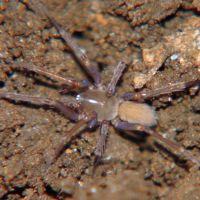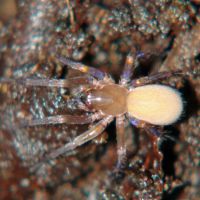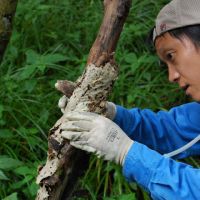An apparently new species of spider has been found in our woods, even though the creature has probably been around since long before humans came to Japan.
To be specific, our spider researcher, Koji Arai, has found an arachnid on our Afan Woodland Trust property in Nagano Prefecture that he believes has never been documented before.
It is a very small spider, about 4 mm long, and it is clearly of the genus Cybaeus — a free-hunter type of small spiders that live on the ground in forests. Both male (smaller abdomen) and female specimens have been found and are now undergoing peer assessment to confirm whether or not this is indeed a new species.
This kind of spider lives in leaf litter and under fallen logs. The young do not set off on long aerial journeys, blown in the breeze on silken lifelines, as many other spiders do. They tend to stick around in their own neighborhood, true "locals" who develop their own characteristics. (I know a lot of people like that, even if they don't have eight legs.)
The fact that there are still undiscovered species in such a highly populated country as Japan is of great significance. Over the past few decades, the planet has lost so many already-documented species. However, here in Japan we can only suspect the extent to which undocumented species have become extinct due to the destruction of old-growth forests, wetlands, natural (unconcreted and undammed) rivers and natural shorelines.
Therefore, I am very grateful that there are people like Arai. He is totally dedicated to his spider research, and although he's generally a quiet, shy, unassuming guy, if you get him started he can tell fascinating spider stories that keep children and adults like me enthralled for hours.
Arai is a graduate of the Tokyo College of the Environment, which I helped to set up in 1994, and of which I am now vice principal. The college has a two-year course and emphasizes fieldwork. First-year students do their basic fieldwork here in Kurohime, where they use our woods for their studies. In the second year, they mostly go to Yakushima Island, south of Kagoshima in Kyushu. Otherwise, they scatter throughout Japan, and when politics and funds permit they study in the Philippines and Africa.
Nowadays, many of our graduates not only work all over Japan, but all over the world in environmental fields: national parks, forestry, wildlife research, education, ecotourism and making television and film documentaries.
Arai became keen on spiders when he was 9, but then gave up his hobby for a long time. However, his interest was fired up again when he entered our college and came on his first long fieldwork trip to Kurohime.
I was 17 when I first took part in scientific fieldwork on spiders. In the early spring, I sailed from Britain to Montreal, Canada, to join Peter Driver, my former biology teacher at school in England. By then, though, he had left his teaching job to become a graduate student at McGill University — and fortunately for me, he needed an assistant to help him with his research into the behavior of eider ducks in the Canadian Arctic.
We spent a month in Montreal getting ready for this expedition, during which time I also babysat his infant son, Alastair, and helped Peter out at the lab. One of my jobs was to feed his tarantula spiders, which he kept in a big glass aquarium. He'd got the tarantulas from Montreal stevedores who found the big black hairy things in the bananas coming in by ship. (Remember Harry Belafonte's 1956 classic, "Day-O [The Banana Boat Song]," which includes the lines: "A beautiful bunch a' ripe banana / Daylight come and me wan' go home / Hide the deadly black tarantula / Daylight come and me wan' go home ... Come, Mister tally man, tally me banana ... ")
Peter's spider tank was made homey with sand, rocks, bits of woody branches and so on. The tarantulas were mostly fed on newly born laboratory mice. I had to go and collect the mice, remove the glass top, and drop the poor little things in. I felt more of a monster than the tarantulas — fast, efficient and fascinating though they were.
Later that summer, when we made our base camp in tundra by Ungava Bay in the Nunavik region of Quebec Province's far north across Hudson Strait from Baffin Island, we had a clear swift river as our water source and a rocky bluff beyond. When the huge snow banks beneath the bluff eventually melted, we were astonished to find a colony of orb-web spiders.
Those amazing creatures, which spent nine months a year buried in snow, made their webs under a big rocky overhang. We named this place "Spider Cliff," and Peter directed me to go to study the spiders and their webs whenever he wanted peace and quiet and I had spare time. There were hundreds of webs, and though they were different sizes they were all made to the same pattern. And, to quote Peter: "As in the Royal Academy, suitable hanging space was definitely at a premium, and there were webs in front of webs in front of webs."
In their short active season, these tundra spiders had plenty of food in the form of mosquitoes, which were there in such incredible numbers they almost drove us mad. Peter and I were definitely rooting for the spiders and enjoyed watching them get big and fat despite having to constantly repair their webs. Over the weeks we noticed that each spider was an individual, and we (mostly me) made sketches of them and their webs and gave them names such as Fred, Charlie, Marmalade and so on.
Without spiders, we would be overrun with other harmful insects, as modern farmers have found out when they use too much pesticide and kill off all the spiders together with the pests. Then, when the more resilient insect pests come back, they come back with a vengeance — and with no predators such as spiders to control their numbers.
Spiders, like dragonflies, are an indicator species, meaning that their presence tells us about the health or state of the environment. Being predators, if there is something harmful in their food, they will be the most affected. Spiders in turn are eaten by birds, shrews, frogs, lizards and more besides, and a big fat spider would surely make a better meal than a whole swarm of mosquitoes — not that I've tried either. I just think they're cute when they gaze up at me with those four pairs of gleaming eyes.
Peter Driver's "Royal Academy" quote in this story comes from his book "In Search of the Eider," published in 1974 by The Saturn Press.



















With your current subscription plan you can comment on stories. However, before writing your first comment, please create a display name in the Profile section of your subscriber account page.